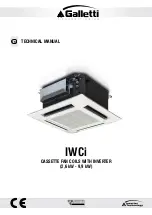
IWCi
14
4
3
2
1
IWCi 3-4-5
A: max cm 12 (IWCi 3-4-5);
max cm 30 (IWCi 6-8-10)
B: max cm 25
A
B
min 2%
1
3
4
2
IWCi 6-8-10
12
It is strictly forbidden to reproduce this manual, even partially
WC66000122 - Rev 03
WATER CONNECTIONS
• 1/2” female (MODELS IWCi 3-4-5) 3/4" (MODELS IWCi 6-8-10) gas
connection on the unit:
- Water inlet: bottom connection.
- Water outlet: top connection.
• For use during cooling, is it essential to have a motorised valve installed,
otherwise you run the risk of having condensation leak out of the tank when
the unit is stopped by the thermostat, or if the condensation pump fails (for
valve assembly refer to the “accessories” paragraph).
Firmly secure the fittings on the unit with a counter spanner
when you are tightening them, to stop the pipes inside the
unit from twisting.
Insulate the water infeed and outfeed pipes well, as well as the devices
installed on the network (stop valves, ...). Use a suitable material for the
conditions of use and water temperature.
• The unit has an air vent installed above the fittings. Depending in the system,
it may be necessary to install other bleed valves on the hydraulic network.
CONDENSATION CONNECTION
• Attach the supplied flexible pipe (2) to the unit's condensation discharge
fitting (1), and secure it with the supplied (3) clamp. Do not push against
the evacuation outlet.
• Connect a rigid PVC pipe (4) to the end of the flexible pipe (2) and secure it
with a supplied (3) clamp.
• Insulate the pipe correctly with polyethylene foam.
• Be careful of the winter frost risk in false ceilings.
• If necessary, it is possible to set the condensation ducting up all the way to
the end of the unit outfeed. Maximum height: cm. 25 (figure 06).
• Make sure that the evacuation ducting is slightly sloped in the direction of
the drain and that no traps develop (figure 06).
• The ducting must be supported by a few brackets (figure 07).
• Do not install an air vent (figure 08) in an incorrect position.
• Do not install the ducting with an upwards slope near the outfeed (figure 09).
You run the risk of having water back flow when the unit stops (figure 09).
7. CONNECTIONS













































